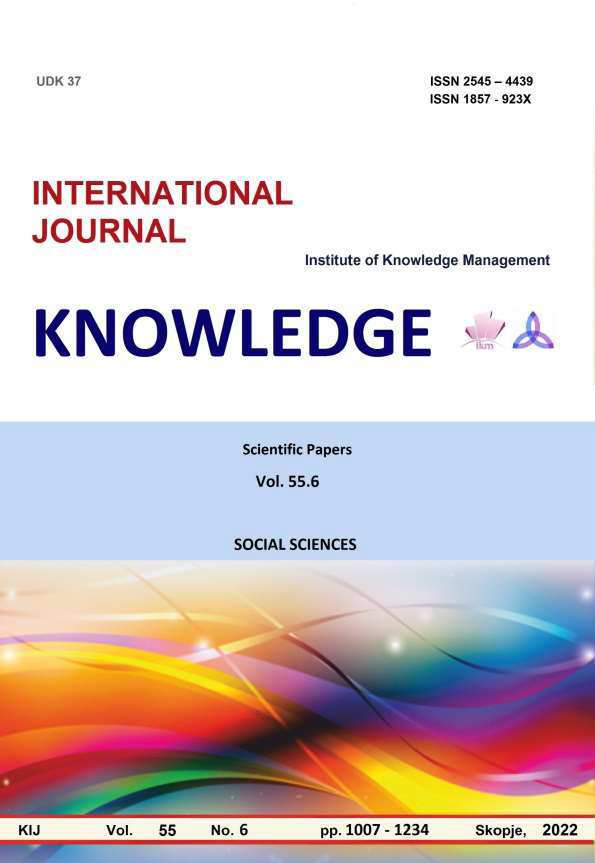THE ECONOMIC COSTS OF YOUTH UNEMPLOYMENT IN NORTH MACEDONIA
Keywords:
youth unemployment, economic growth, Okun’s law, growth rates, youth unemployment ratesAbstract
Youth unemployment is an issue that seriously concerns many countries, both developed and developing
countries. Youth unemployment rates (as % total labor force ages 15-24) in North Macedonia is (36.9% in 2020),
and despite recent improvements in labor market indicators, it has remined relatively high in comparison with the
rest of Western Balkans countries (35.08% in 2020) and the EU average level (14.4% in 2019).
High youth unemployment and inactivity provoke many negative consequences both for young individuals and for
the whole society. For young people the long-term unemployment status negatively affects their prospects to find
decent jobs, increase the social exclusion by losing of their skills and qualifications; and have negative impact on
health status. For society the costs of youth unemployment and inactivity include higher fiscal costs due to
unemployment benefits, forgone earnings, and taxes; increase poverty and income inequality; and reduce the
aggregate consumption. Also, the high rates of youth unemployment provoke migration process of young population
from a country, which may jeopardize the prospects of country’s future economic growth.
Facing with the problem of high youth unemployment rates, in the several past years, North Macedonia have
proposed and implemented different policies and measures to decrease the youth unemployment rates (National
Youth Strategy 2016-2025, Youth Employment Action Plan 2016-2020, Youth Guarantee plan (2020-2022, and
etc). In that context, North Macedonia was the first country, outside from the European Union, that has implemented
the Youth Guarantee program in 2018, as a pilot project. And since 2019, the Youth Guarantee program has become
a regular part of the youth labour policy. All these policies put the focus on improving education and working skills
because it is expected that education increases chances for employment of young people, especially for those that
belong to NEET category.
Output and unemployment commonly move together. There are a number of empirical research with focus on the
link between the output change and change in the unemployment. The most prominent one is the empirical research
of Okun (1962) who defined the relationship between the change in the unemployment rate and the change of output
growth rate. Therefore, the concept of the Okun’s Law is often used as a basis for developing of econometric models
for estimation of the cost of unemployment in the economy. Calculation of economic costs is very useful for policy
makers as a tool for evaluation of the costs and benefits of policy measures for increasing the employability in the
economy.
Thus, the focus of this research is to calculate the costs of GDP form youth unemployment in North Macedonia in
the period from 2010 to 2021. For that purpose, based on the MakStat database of the State Statistical Office of the
Republic of North Macedonia (SSO), authors developed an econometric model to calculate the loss of GDP form
youth unemployment. From the obtained results, costs from total unemployment are on average 1.62% from
potential GDP over the period 2010-2020, while the costs from youth unemployment varies from 0.57% in 2011 to
0.14% in 2020. Also, authors discuss results and give some recommendations for overcoming the challenges of high
youth unemployment.
References
An Z., A., Bluedorn, J. & Ciminelli, G. (2021). Okun’s Law, Development, and Demographics: Differences in Cyclical Sensitivities of Unemployment Across Economy and Worker Groups, IMF working paper WP/21/270
Anderton, R., Aranki, T. Bonthuis, B. & Jarvis, V. (2014).Disaggregating Okun’s Law: Decomposing the Impact of the Expenditure the Impact of the Expenditure Components of GDP on Euro Area Unemployment, Working Paper Series, No. 1747, December, European Central Bank
Balan M. (2014). “Analysis of Unemployment among Young Individuals from Romania by Econometric Methods”, Journal of International Auditing & Risk Management, 3 (35), 90-97
Bartlett W., Guxholli, S. & Jovanovski, P. (2021). Study on Youth employment in the Republic of North Macedonia, Ramhorst Amira (editor), Regional Cooperation Council
Fiti T., Filipovski. V., Bogoev. J., & Trpeski. P. (2013). Potential GDP and natural rate of unemployment in Republic of Macedonia., Academy for sciences and Arts of Republic of Macedonia
Grinevica L. & Riva B. (2017). Economic Costs of Youth Unemployment in Latvia, Research for rural development Vol.2 (pp.270-275)
Lee, J. (2000). “The Robustness of Okun’s Law: Evidence from OECD countries”, Journal of Macroeconomics, 22, 331-356
Moosa, I.A. (1997). “A cross – Country Comparison of Okun’s Coefficient”, Journal of Comparative Economics, 24(3), 335-56
Okun A. M . (1962). “Potential GDP: Its measurement and significance”, Proceedings of the Business and Economics Section, 98-103, American Statistical Association
Petreski, M. (2021). How Migration, Human Capital and The Labour Market Interact in North Macedonia, Report drafted for the European Training Foundation under the supervision of the Vienna Institute for international Economic Studies
Putun M., Karatas A.S., and Akyildiz I.E. (2017). “The Economic Consequences of the Youth Unemployment Case in EU Countries: A Critical Analysis”, International Journal and finance studies, 9 (1), 77-99
Sadiku M., Ibarimi, A. & Sadiku, Lj. (2015). “Econometric Estimation of the Relationship between Unemployment Rate and Economic Growth of FYR of Macedonia”, Procedia Economics and Finance, 19, 69-81





